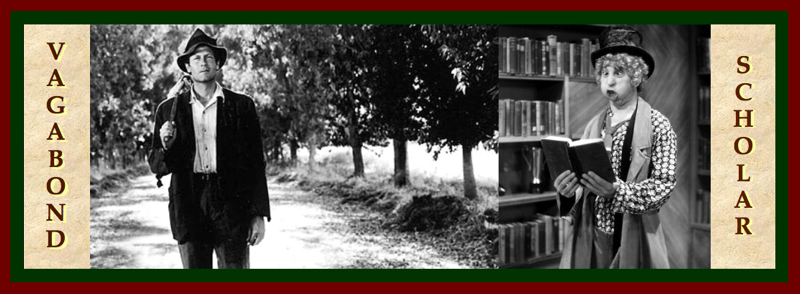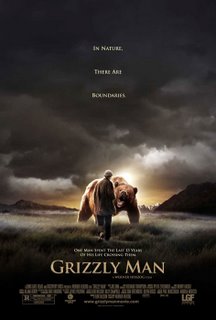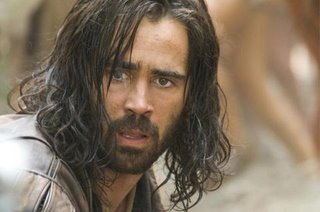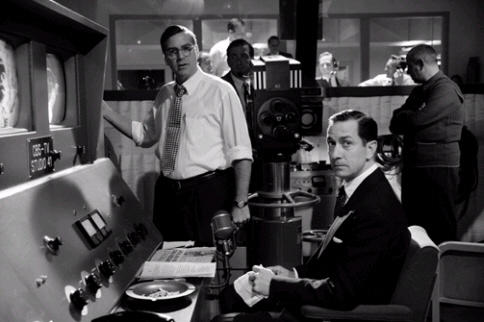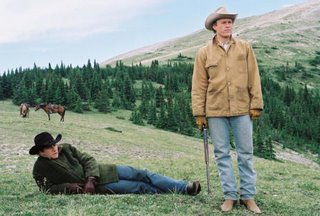 Brokeback Mountain
Brokeback Mountain Beyond all the hype and jokes,
Brokeback proves to be a very good film, elegiac and unsettling, quiet but moving. Like many of the best westerns, it uses the landscape itself as a character, and like many a successful film of forbidden love, it makes one care about its characters. The understated, Oscar-winning score by Gustavo Santaolalla hits the perfect note of passion under restraint, of suppressed desire and quiet yearning.
The Hulk excepted, Ang Lee has long been one of his generation’s best, most nuanced directors, as can be seen in
The Wedding Banquet, Sense and Sensibility, The Ice Storm, and
Crouching Tiger, Hidden Dragon. Heath Ledger has never necessarily been godawful, but it’s a testament to Lee’s consistent ability to coax out good performances that Ledger actually deserved his Oscar nomination as the strong-but-silent Ennis. I must be honest — I’d rather see a love scene with Maggie Gyllenhaal than Jake. But
Brokeback’s great strength, that prevents it from being “issue cinema,” is that Lee always focuses on the specificity of his characters. As much as Ennis embodies the archetypical cowboy (albeit a gay one), ultimately, these are individuals, real people, not types. Care about the person and the “issue” becomes irrelevant. That said, at times Lee plays with iconography a little too much, as when he has his gay cowboy fight a crude man in defense of his woman’s honor. Lee makes a point of showing Ennis in a low wide shot, standing above his vanquished foe, with the fireworks exploding behind him, while his wife, who tradition dictates should be proud of him, cowers from him in fear (apparently something is awfully rotten, or queer, in the state of Wyoming.)
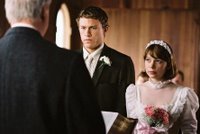
While Michelle Williams has some nice moments, I found her performance overhyped, while Anne Hathaway delivered a very subtle, understated performance. Perhaps it’s no coincidence that our gay cowboys are surrounded with sexually forward women, whether that’s ultimately to their benefit or not (it certainly winds up being rough on the women in the end). Surely there’s some brutal tension there as both lonely men try to make their marriages and subsequent heterosexual relationships work, even while they have an irresistible but potentially life-threatening attraction to each other. A real tenderness creeps into Ennis’ relationship with his oldest daughter, too, despite the painfully taciturn nature of both.
The funniest objection I heard to
Brokeback’s coverage was “they’re not gay cowboys! They’re gay shepherds!” If only all the criticism was as good-natured. I must confess I got sick of reading about people, mostly men, bragging about not going to the film, the most insufferable probably being professional crank and blowhard Mickey Kaus at
Slate. I also found one conservative critic’s exhortations asinine, that the scene where Jack (Jake Gyllenhaal) faces down his father-in-law L.D. Newsome (Graham Beckel) and makes him back down was gay liberal propaganda, that the scene was completely unrealistic but made to appease all the liberals that the big bad homophobe was defeated. That’s crap. I watched that scene very much engaged, wondering which way it would ultimately play out, because I’ve seen such family power struggles in real life and have heard many a story. I would have bought any of a number of outcomes.
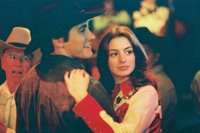
The biggest question for me was, would Lureen (Anne Hathaway) back up her husband, or side with her father? She chooses to remain quiet, her true feelings somewhat unclear, but by default siding with Jack and avoiding a direct confrontation with her father. Even though Jack loses his cool, he is clearly in the right, and defending his wife, L.D.’s daughter, and her authority as well as his own. A character like L.D. typically only respects strength, and Jack’s move would likely earn his grudging respect. I could also buy L.D. yelling or storming out, but especially because his daughter and wife do not back him up, and he is not on his own turf — and because I know of similar scenes in real life that have played out almost exactly this way — I bought it. A less believable scene for me is when Ennis threatens his ex-wife Alma (Michelle Williams), because nothing in her overdue voicing of suspicions that he’s gay is a threat; it’s about her own pain. Still, considering the stakes for Ennis, and the danger he’s under, I could excuse it.
There’s a common conservative assumption (read the
National Review Online and elsewhere), seen with three of my top five, that Hollywood is some monolithic, uniform entity waging a coordinated cultural war against their otherwise unsullied, perfect way of life (“Won’t turn me gay, nossir!”). The truth is Hollywood has always cared about the color green the most, and it’s a bit of a coup anytime a good film makes it way through the system. No major studio was clamoring for
Brokeback, Syriana, and
Crash to be made, and the filmmakers faced some stiff resistance to their projects, due to subject matter, complexity, and perceived marketability.
Brokeback is not flawless, and does drag at points. Still, forget the hype, forget the jokes, and see it because it’s first and last one of the best films of the year.
 Syriana
Syriana Writer-director Stephen Gaghan deliberately creates a mosaic of interweaving storylines that prove confusing and difficult to fully process at first glance, because his ultimate point is that no one can easily see all the connections, in this case when it comes to the international oil business.
Syriana never falters because the individual scenes are so intriguing and we never doubt that Gaghan is ultimately leading us somewhere worthwhile. Gaghan reports that
Syriana takes its name from a potential country to have been carved out in the Middle East by the British in the 20th Century. Since this is far from common knowledge, the title serves as an evocative cipher, but hints at the truth that the west has always taken a dominating interest in the Middle East. Perhaps my favorite scene involves Jeffrey Wright telling a client at a barbeque, “We need the
appearance of propriety” — but only the appearance, because after that, it’s business as usual. Subsequent scenes involve shopping for, and bargaining for, a few fall guys (former CIA agent and source author Bob Baer claims that corruption in the oil business is unavoidable and the U.S. oil companies are actually less corrupt than their European counterparts). While Clooney really won his Oscar for his multiple hats this year, he's quite good in this film, particularly in his scene with the always solid Christopher Plummer.

Matt Damon has a few flashy speeches, but his character is compelling, partially because his personal grief allows him to be far more candid than he ever would be otherwise. As his wife, Amanda Peet draws a convincing character in just a few strokes. The portrayal of two young suicide bombers is sensitive without condoning their activity. And finally, Alexander Siddig, in one of the film’s most affecting performances, plays a Middle Eastern prince who desperately wants to improve his country, but that may mean going against U.S. interests, leading to a series of crucial confrontations. While
Syriana made me think more than it made me feel, it made me do both. It’s quite an ambitious film, but I would argue it fulfills its ambitions, and I find it’s stuck with me long after seeing it.
Confounding many a critic is that art can say more than one thing at once and to understand is not to excuse (see
Munich, below, on this note). In
“Hollywood’s Crude Clichés,” the occasionally-liberal columnist Richard Cohen objects to
Syriana because he thinks its politics are simplistic and unrealistic and that it’s about the latest Iraq war.
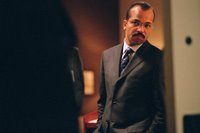
But of course, it’s not about the Iraq war, it’s about oil, and those are not quite the same thing. In his ludicrously-titled piece
“Oscars for Osama,” conservative columnist Charles Krauthammer objects to
Syriana because he thinks its politics are simplistic and unrealistic and it celebrates suicide bombers as “the moral high point of the movie.” Of course, Krauthammer’s misreading is even stupider than Cohen’s (Jim Emerson responds to Krauthammer
here). For the most part,
Syriana does not judge its characters, it merely presents them. As for its realism, I contend that the real schism is that the meticulously-researched
Syriana refuses to conform to Cohen and Krauthammer’s worldviews, but that’s ultimately a condemnation of them.
The Hill reports a former Director of the CIA feels it didn’t go far enough:
When Gaghan and Baer took questions after the screening, the most pointed came from “Jim,” who only some in the audience knew was former CIA Director Jim Woolsey.
Why didn’t the filmmakers depict just how severe the retribution was, Woolsey wanted to know, and just how far up the chain of command it originated? Was it because Middle America wouldn’t believe that the powers that be in Washington would have gone after a decorated operative like that?
Yes, replied the writers, that is exactly why.
I am not an expert on espionage in the Middle East, nor the oil business, but personally, I found nothing in
Syriana so far-fetched or outrageous as to strain credulity. What’s its dread secret? That individuals, corporations, and countries act in their own self-interest? That powerful players don’t always care about morality or legality? (The horror! The horror!) See it, and judge it, for yourself.
(You can hear Bob Baer speak about
Syriana here. You can hear Gaghan on
Day to Day here. (You can hear Jeffrey Wright with Ed Gordon
here.)
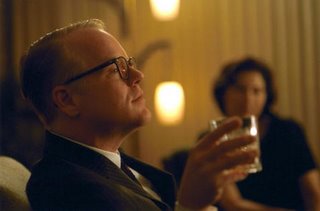 Capote
Capote Some critics have tried to peg
Capote as primarily a showcase for Phillip Seymour Hoffman’s Oscar-winning performance, but that overlooks the fact that it’s also an extraordinary debut feature from director Bennett Miller with a superb script from Dan Futterman (based on Gerard Clark’s book). The film’s understated approach is almost pitch-perfect, as we follow Truman Capote through a moral labyrinth of preening, connection, sympathy, and heartless manipulation. The supporting cast is strong, with Catherine Keener (Harper Lee), Clifton Collins Jr. (as killer Perry Smith) and Chris Cooper (Sheriff Dewey) particular standouts.
Of course, my praise for the other elements aside, Hoffman outdoes himself with an absolutely stunning, captivating performance. Despite the fact that he’s a hulking bear of a man playing a diminutive one who had a very distinctive, affected voice, Hoffman makes it work. He’s close enough to Capote to evoke him without trying outright mimicry. Above all, he captures his relentless egocentrism and mercurial nature. At first, when he and Harper Lee arrive in Kansas, Capote seems hopelessly out of place and it seems he’d be utterly helpless without Lee to shepherd him through the harsh world. But when Capote is allowed to work a crowd, or a person, you see his skill as a charmer. And his interactions with the killer Perry Smith, with whom he identifies, possess a fascinating progression (eerily, Collins looks similar to Robert Blake, who played Perry Smith in the great film
In Cold Blood). While Capote is at first sympathetic to Perry, he increasingly becomes a vulture, and we get to see how great journalism and human compassion may ultimately be at odds.
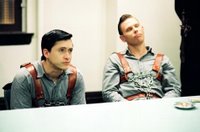
The film features at least three brutal or revealing scenes. One is at a party celebrating the film premiere of
To Kill a Mockingbird. It’s Harper Lee’s night, but Capote can only think of himself, outrageously so. It’s a measure of Lee’s maturity that she knows her friend so well as to not be upset; at most she’s slightly disappointed (throughout the film, it is she, and Sheriff Dewey, that serve as Capote’s conscience, not that he often follows their counsel). A second, disquieting scene shows Capote pushing Perry finally to tell him about the murder. For the first time, he gets insulting, working over Perry, suggesting that Perry’s only worth as a human being is to provide the story Capote wants. The third is more a sequence than a scene — as Capote must speak to Perry and his fellow killer Jack Dunphy (Bruce Greenwood), and watch their deaths. While Capote has earlier earned the ire of the Sheriff for hiring an attorney to help the killers, he winds up dialing back significantly on his assistance — in large part because the best ending, or
only ending for his book (often called a non-fiction novel) is their execution. Capote can only really consider this, or anything, in terms of how it affects himself. As these two killers finally, unavoidably are to executed, Capote cannot help but feel guilty, and with good cause.

Part of the genius of the film
In Cold Blood is that one can utterly decry the horrendous murders but still feel some sympathy for the killers. The excerpts I’ve read of the book possess the same feel. Even if one feels they deserve to die, it seems just one more sad chapter to the whole dreadful affair. We can feel grateful for Capote’s celebrated book, and its splendid film adaptation, but after seeing
Capote it’s hard not to wonder about the human cost of producing it.
Capote proves itself a superb film because it creates the same feeling, the same interest and indictments. We want to hear Perry’s story, we want to see Capote succeed, but in the final sobering minutes of the film, it’s also hard not to share some of the haunted feeling so evident in Hoffman’s face as Capote.
(You can hear Phillip Seymour Hoffman on
The Treatment here. Hoffman speaks about his Capote obsession on
Day to Day here. Capote biographer Gerald Clarke says Hoffman's performance is "true to the man" on
All Things Considered here. Finally, you can hear Dan Futterman (writer) and Bennett Miller (director ) on
Weekend Edition here.)
 Match Point
Match Point Roger Ebert’s called it one of Woody Allen’s best five films ever, and I’m inclined to agree. Essentially, he takes one of his best films (and one of my all-time favorites),
Crimes and Misdemeanors, strips away the comedy and makes it a straight drama-thriller.
Crimes and Misdemeanors possesses a wit, thoughtfulness, and a thematic density that approaches
King Lear and its ultimate source material,
Crimes and Punishment. Yet
Crimes and Misdemeanors also has a more cosmic, objective feel, while
Match Point, for all the cerebral moments of some of its characters, is a much more subjective and passionate film.
Match Point also answers one of my biggest questions from
Crimes and Misdemeanors — if the central marriage was truly intimate, wouldn’t the wife suspect something when her husband cheated on her, or committed some dread act? Wouldn’t some shift be noticeable? Emily Mortimer delivers a superb performance as Chloe, the wife of Chris (Jonathan Rhys Meyers). While she’s too trusting of Chris when he starts to stray, she’s also perceptive enough to sense something’s off and to ask the questions, even if she does not press for answers.

Scarlett Johansson is certainly a convincing choice for the object of Chris’ lust, Nola, but while she’s a very promising young actress, she does feel a bit out of her depth here. Still, the key performance here is Meyers as Chris, and he’s fantastic, utterly convincing as a young, intense, very ambitious young man with serious control issues and a rapacious appetite. Judah (Martin Landau) in
Crimes and Misdemeanors issues one of the all-time dazzling character lines, “God is a luxury I can’t afford,” and similarly, Chris pursues his own pleasures with little heed for the consequences, daring fate or society or those he supposedly loves to catch him and play his conscience. Woody Allen starts with an absolutely brilliant visual metaphor that he references later at a crucial point in the film — but it turns out we simply can’t predict which way things are going. (In a funny bit of casting, Allen’s Scotland Yard is staffed by actual Scots!) This is an exceptionally well made if unsettling film.
At this point, I’m going into major spoiler territory, so stop if you don’t want to know.
At least one person I know did not like the ending, and wanted Nola to defeat Chris, to his surprise. I have to disagree strenuously. My response, and my apologies for some repetition, was that:
Match Point is essentially Crimes and Misdemeanors, except as a drama-thriller, and more subjective and character-focused. And both are loosely inspired by Crime and Punishment, in which Raskolnikov gets away with a murder... only after he's cleared, he confesses and eventually earns redemption, primarily through the selfless love of Sophia. The main character in Match Point earns a different fate... so in one sense, he gets away with murder, but in another sense, he really doesn't. The ending has to be as it is. As with Crimes and Misdemeanors, that's really the whole point. "God is a luxury I can't afford," is the great line from that film, where Judah expresses arrogantly that morality essentially exists only to the extent that it is convenient. In King Lear, all of the evil folk are punished, but so are the good. In Les Miserables, some of the good earn their reward, but at least two of the villains escape. In Crimes and Misdemeanors, the good guy gets screwed, essentially, while the murderer gets away with it. Won't the main character in Match Point be tormented the rest of his days? Even without "earthly justice" in the conventional sense, will he truly get away with it? If he does, does it matter? As with King Lear, or the other works mentioned, Match Point challenges the idea that justice will be done, and that in the end, the good will prosper and the evil shall not. Because of that, it can leave some people feeling very unsatisfied. By the film's end, I feel uneasy, but that's the whole point... The Murderer gets away based on luck... although when the ring bounces, we think it's going to sink him.
Yes, it would be ironic for Nola to triumph, but that's a different movie. That's not this one. I think this one needs to be as it is. With the luck theme, the ending could play out differently. But that wouldn't quite feel right.
The film is focused on Chris, not Nola. The ironic-victim-triumphs-tale is Wait Until Dark, in a sense... but that's focused on the woman. In Crime and Punishment, Raskolnikov is spotted by passersby, and actively pursued by a policeman, who knows he did it... but ultimately can't prove it.
And, considering the source material... Crimes and Misdemeanors and Crime and Punishment... the murders were an integral part of the story before Allen started, it's just not apparent at the start of the film.
If Chris doesn't get away with it, he never has his moments of conscience (or rather, denying it), nor does he get to face the prospect that he will indeed get away with it... what's interesting about him getting caught? Haven't we seen that on a thousand Law and Orders and other cop shows? Too simple for Dostoevsky or Woody Allen. Chris’ moment of collapse, crying after the first murder is one of the most riveting, disturbing moments in the entire film, and perhaps the most honest and unique aspect of the entire story, as the reality of his self-serving plot absolutely crushes all the rationalizations he has constructed to justify his horrible actions. And despite all that... he pushes on. By the film's end, I feel the most for Chris' wife and kid. But I think he will be forever haunted, or at the least, tainted.
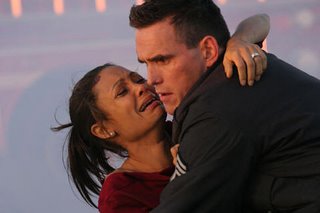 Crash
Crash I was honestly surprised by all the backlash against
Crash. Just as I’ve vowed to give it another look, I’d ask all its critics to do the same. When writer-director Paul Haggis accepted his Oscar, he quoted Bertolt Brecht about art not being a mirror, but a hammer. I was also reminded of what one of my directing teachers once said, that Eugene O’Neill as a playwright was “powerful, but artless.” Perhaps these fit
Crash, but honestly, I felt for all its highlighted, “hyper-moments,” there was plenty of humor and many more levels to the film, if nothing else due to some fine performances.
Crash to me was a small independent film, with a strong cast but shot for virtually no money and with little interest from the studios. I heard about it from strong word of mouth and went to see it a few weeks after it had opened, concerned that it wouldn’t last long. I was impressed that, even at a multiplex, the theater winded up being packed and everyone in the audience seemed to respond strongly and positively to the film. Perhaps seeing a film so strongly set in LA in LA helped. But after knowing more of the background of its making, I still can’t see it as anything but an underdog.
Most of the objections to
Crash I’ve heard posit that its message is that “everyone’s a racist.” They felt preached to. I felt neither of these things with
Crash. I don’t think it’s necessary to think “everyone’s a racist,” or to feel “white liberal guilt,”
or to feel some backlash against the suggestion that one must feel a certain way. Personally, I absolutely hate,
hate feeling manipulated by any filmmaker or condescended to in any forum, and if
Crash made me feel that way, I’d condemn it in a heartbeat. While race is certainly a central issue to
Crash, I feel (as does Don Cheadle) that it’s very much about power, and feeling helpless and disconnected. Aaron Sorkin remains the master of the displaced anger storyline, but
Crash does pretty well, as almost every angry person lashes out at the wrong person or persons in their pain and rage. Racism, as an issue, is not depicted as the problem of just one race. Here’s what I really like: absolutely no one is let off the hook. Every single major character is confronted with at least one extremely difficult moral situation, where doing the right thing is not easy if it even exists. It’s also very hard to do an interweaving character story well, and I feel
Crash did it very well. And, I really like some of the actors in the piece, most notably Don Cheadle and Thandie Newton (I hadn’t seen Terrence Howard before, but I found him very impressive).
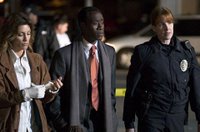
A few comparisons are in order. Race is an issue that I feel is typically best handled by documentaries, because the Hollywood approach tends to be too, pun intended, black and white. I know at least one intelligent person who really liked
A Time to Kill, but while I loved its superlative supporting cast, I found it very simplistic, with most of its characters victims, stock villains or disengaged heroes. I find
Crash to be more insightful on race, or at least allows for a better discussion of it. In terms of manipulation, I adore the acting in
Breaking the Waves (Lars von Trier gets fantastic performances) but I find von Trier’s approach hopelessly manipulative and heavy-handed. He so desperately wants to ennoble his heroines through suffering he concocts highly-implausible plots to achieve this, and while some folks are drawn in by his pseudo-doc style, for me it constantly reminds me of the artifice of the entire venture (I find
Dancer in the Dark his most effective film). As for interweaving storylines, many a film has tried this, but the most obvious comparison to
Crash is
Magnolia (one of my three favorite films of 1999). I view
Magnolia as a lovely mess, a series of striking vignettes that nonetheless fail to build to a coherent whole, meandering, and with at least one completely extraneous storyline. That being said, there’s no doubt that
Magnolia’s vignettes are more original, powerful, believable (well, other than the frogs) and effective (also, its KCRW soundtrack by Aimee Mann, led by the brilliant “Save Me” completely outclasses “In the Deep”). Still,
Crash does weave its tales more coherently and tightly than
Magnolia (or
Short Cuts, or a number of other films), whether or not you think that’s a good thing, and whether or not you think it cheats to do so.
Crash does present a hyper-reality, and does create too many artificial parallels and coincidences, but I nonetheless found it a recognizable world. Its biggest coincidence is the scene where Matt Dillon must rescue Thandie Newton. At least one critic felt this scene was meant to excuse Dillon’s character of his faults, but I’d disagree. I was willing to excuse the coincidence and the melodrama because of where it allowed the characters to go. I really was not sure of the outcome. But the scene wasn’t about Thandie Newton for me, although as usual, she’s riveting. It was about Dillon. Suddenly, he’s confronted with his own racism, and forced for the first time really to see himself as others see him. There’s some shame there, the urge to protest, “no, really, I’m not like that.” While he acts heroically, I didn’t feel the incident let him off the hook – instead, it’s shook him to the core. Sartre would call his moment “a sudden realization of self,” forced by another’s gaze. Perhaps it will change him. Maybe not. Seeing his frustration dealing with his ailing father, I see the source of his anger, displaced into racism. I understand it but I do not condone it, nor do I feel Haggis is asking us to. I’m comfortable with that moral complexity.

Similarly, I wasn’t sure of the outcome for the infamous traffic stop, nor of Ryan Philippe interceding for Terrence Howard, nor the magic cape scene. I cared about the characters but didn’t know the outcome, and the outcome mattered to me, so I was very engaged (I did predict the secret of the magic cape miracle, but it got me for a few seconds). Perhaps I’ll feel differently when I see the film again and know the outcomes. Don Cheadle has observed that many people he’s met use the film to talk about some aspect of race or power. They can refer to “that scene in
Crash” and thus discuss their feelings without, y’know, directly discussing their feelings about touchy issues. I never doubted that the traffic stop scene could actually happen, and that it was true to
someone’s experience if not my own — but what I found affecting was the loss of power, the shame. Even in the most intimate, close relationships there can come an issue or event that becomes dangerously divisive. As they depict a married couple, Thandie Newton and Terrance Howard have the sort of raw conversation not everyone has about very touchy subjects that encroach on their very sense of identity. They must ask themselves not only how well they know each other, but whether they can even stay together. Similarly, I felt for Ryan Philippe doing something absolutely terrible and not being able to take it back, and Don Cheadle stuck in the impossible situation of being horribly misjudged by his own mother but constrained by honor and compassion not to correct her.

The other aspect I feel some people missed with
Crash is much of it is intentionally funny. Critic David Edelstein (a link is below) decries the opening monologue by Don Cheadle about the urge to “crash into one another” just to feel something as amazingly hokey, completely ignoring that Haggis has Jennifer Esposito undercut the speech with exactly that sentiment moments later! It’s fine to say that the undercut doesn’t work or doesn’t excuse the speech, but to ignore the undercut is to misrepresent the film. Don Cheadle’s dismissive ignorance of his own girlfriend’s ancestry is both offensive
and funny simultaneously. Brendan Fraser as a D.A. ranting about the difficulties of racial perceptions was outrageous but very funny (my thought was, surely if such conversations don’t take place, they do internally). Similarly, Ludacris and Larenz Tate form a sort of Greek chorus, by turns insightful, preposterous and funny. In one moment they decry racial stereotypes about being gangbangers and in the next, embody them by pulling guns!
Crash kept me guessing, and constantly asked me to re-evaluate my view on any given character. My sympathy was initially with Sandra Bullock after her car-jacking, but after she goes onto a tirade, my feelings shifted to the innocent target of her ire, the locksmith played by Michael Peña.
I’ll be interested to see how I feel about
Crash upon a second and third viewing. But as with
Syriana and the other films in my top five, I found it both moved me and made me think. I’ll put up with some questionable choices for that anytime.
(You can hear Don Cheadle on
The Treatment here; this is the one to hear if none other. Roger Ebert compares
Crash’s multiple characters to Dickens’ work
here. He speaks about some of the backlash against it
here, noting its awards from the African-American Film Critics Association, which you can read
here. You can hear Paul Haggis on
The Treatment here. He discusses
Million Dollar Baby on
Fresh Air here. Elvis Mitchell (host of
The Treatment) talks with NPR's Scott Simon on
Weekend Edition about
Crash and Hollywood's treatment of racial issues
here. You can hear Bob Mondello discuss the film on
All Things Considered here. Bob Mondello interviews Haagis and Brendan Fraser on
Talk of the Nation here. There’s a good pro and con discussion about
Crash on
To the Point here, (7:50 into the show to about 42:00) . There’s a link to the
LA Times article cited on
To the Point on one activist’s
website. You can hear a
To the Point postmortem
here. Linda Wertheimer and Joan Kaufman discuss
Crash on
Weekend Edition here. Ed Gordon on
News & Notes interviews Larenz Tate and Chris 'Ludacris' Bridges
here. David Edelstein’s review is
here.)
Special Mention Saraband
Saraband (first screened on Swedish TV in 2003) Ingmar Bergman, turning 88 this year, has announced his retirement more times than Michael Jordan. While he continues to have his plays adapted and may even pen another screenplay or novel,
Saraband is his final film directing. This is a shame, because there's simply no one else who delves into intimacy, yearning, and alienation with as unflinching a gaze as Bergman.
In the Bedroom was a good film, but American Bergman-lite. Eric Rohmer, another great master, comes closest to Bergman in terms of capturing the complexities and subtleties of real life on film, but Rohmer is French and far happier than the brooding Bergman. Rohmer is the cinematic equivalent of Chekhov without the extreme tragedy, while Bergman is pure Dostoevsky.
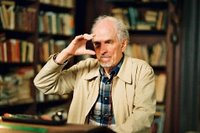
In
Saraband, Bergman uses two characters from one of his earlier, great films,
Scenes from a Marriage, but it is not really a sequel – Bergman (like Rohmer) tends to use the same actors over and over again, so it's more an issue of economy. Bergman certainly knows something about marriage, especially those that fail – one biography lists five marriages for him and at least nine children. That's not to mention his other lovers, the most famous of whom stars in
Saraband, the ever engrossing Liv Ullman, as Marianne.
Saraband, taking its name from a type of dance, is a series of about 10 two-person scenes plus a prologue and epilogue with Ullman. In the first 6 segments, Bergman runs through every possible two-person combination of his 4-person cast, then moves on to re-examine some of these relationships and the fallout from earlier scenes.

It's a bit jarring and disappointing to see one of the great masters of the medium use high-end video versus film for his last venture; apparently Bergman wanted to be able to move faster on set and likely does not have the stamina of his youth.
Saraband also features some odd and jarring video effects at a few points, most utilizing a photo of Bergman's much-beloved wife Ingrid (who died in 1995) standing for a character in the film whose death has thrown three of the characters' lives into disarray. Regardless,
Saraband is well shot, and while it is not a masterpiece, it is a welcome, worthy addition to the Bergman canon.
The scenes shift from poignant to disturbing, but are always engaging, possessing the ring of truth. With each new scene, Bergman creates a minor
Rashomon effect as we see directly a character we'd only heard about previously, and our feelings about each person gradually shift over time (predictably with Bergman, the women emerge more likable than the men).
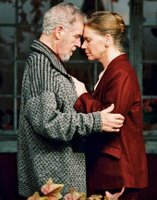
After seeing his present relationship with Marianne, at first we think Johan (Erland Josephson), the egocentric husband from
Scenes from a Marriage, has softened considerably over time. Reflecting on his relationship with Marianne, he has a great line about the secret to a successful marriage being a close friendship and an unflagging eroticism; they still succeed at the former, but lost the latter. Yet later on, one of the most devastating scenes in the film plays out between Johan and his middle-aged son, Henrik (Börje Ahlstedt, the father from
Fanny and Alexander). Henrik comes to beg a favor on behalf of his daughter, Johan's granddaughter Karin (young Julia Dufvenius, in an extraordinary performance that shows the torch has been happily passed). When Henrik was a sullen young man, Johan, never the candidate for father of the year, once actually reached out to him and was rebuffed. It seems Johan never forgave Henrik for this, and never tried again. You want to reach through the screen and shake Johan – "for god's sake man, he was a teenager! Of course he was moody and pushed you away!" but Johan's judgments are absolute. If nothing else,
Saraband delves not only into the redemptive power of love, but also a poisonous, possessive brand of it that can be passed on from generation to generation. While at its most brutal,
Saraband, like other Bergman films, deals with characters who feel that one they love has failed them somehow, in the end it becomes more a meditation on the unavoidable imperfections of close relationships. All four characters face this truth, even if some never fully reconcile themselves to it.

 Robert Pinsky and Maggie Dietz founded the wonderful Favorite Poem Project. Longtime viewers of The News Hour with Jim Lehrer will remember seeing some of the videos shot for the series (you can view them on their site). They’ve also published several excellent poetry anthologies (one, two and three). Each summer, Boston University, where Pinsky teaches, hosts a week-long program currently called The Poetry Institute (or Summer Poetry Institute) for educators. It also features readings by prominent poets that are open to the general public. This year’s application deadline is May 30th. The original plan was to start similar programs at major universities in other regions of the country, and I hope at some point that comes to pass.
Robert Pinsky and Maggie Dietz founded the wonderful Favorite Poem Project. Longtime viewers of The News Hour with Jim Lehrer will remember seeing some of the videos shot for the series (you can view them on their site). They’ve also published several excellent poetry anthologies (one, two and three). Each summer, Boston University, where Pinsky teaches, hosts a week-long program currently called The Poetry Institute (or Summer Poetry Institute) for educators. It also features readings by prominent poets that are open to the general public. This year’s application deadline is May 30th. The original plan was to start similar programs at major universities in other regions of the country, and I hope at some point that comes to pass.  There’s a saying that if you want to have a good conversation about education, ask someone about the best teacher he or she’s ever had. Anyone who thinks public education is dead should meet the teachers I had the privilege of working with that summer (almost all were on the high school, middle school or elementary school level). About a year after our session, Boston University hosted a reunion for us to compare notes and share new lesson plans. I went in thinking, “my class is pretty good,” but in the face of the amazing lesson plans I heard, I wound up thinking, my god, I have the most boring class ever! Honestly, it was a great feeling. The most dangerous pitfall of teaching is getting burnt out, and listening to an enthusiastic colleague or sitting in on a good class is inspiring. Hearing a good poem read by someone who really loves it does much the same thing.
There’s a saying that if you want to have a good conversation about education, ask someone about the best teacher he or she’s ever had. Anyone who thinks public education is dead should meet the teachers I had the privilege of working with that summer (almost all were on the high school, middle school or elementary school level). About a year after our session, Boston University hosted a reunion for us to compare notes and share new lesson plans. I went in thinking, “my class is pretty good,” but in the face of the amazing lesson plans I heard, I wound up thinking, my god, I have the most boring class ever! Honestly, it was a great feeling. The most dangerous pitfall of teaching is getting burnt out, and listening to an enthusiastic colleague or sitting in on a good class is inspiring. Hearing a good poem read by someone who really loves it does much the same thing. 